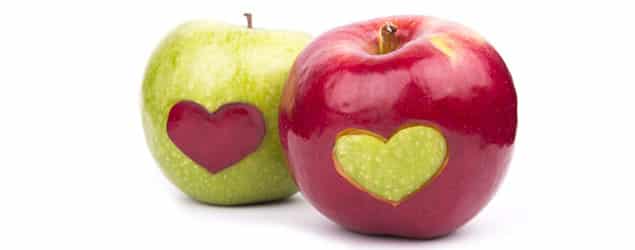How do you like them GMO apples? (#GMOMonday)

Did you know that the average American eats about 16 pounds of apples every year? That number used to be more like 20 pounds back in the 1980s, but the iconic apple has fallen out of vogue. A new genetically engineered version of the fruit has the potential to have people reaching for them more often (especially the sliced version).
Today is “Genetically Modified Monday” (#GMOMonday), the day of the week I am setting aside to think about and talk about some exciting and intriguing new genetically modified foods. You can chime into the discussion by tweeting, using the hashtag #GMOMonday (“GMO” stands for “genetically modified organism”). What are some of the improved foods you are thinking about or enjoying today?
This week, I want to talk about one biotechnology company’s plan to take the apple industry by storm by making an old standby fruit do a pretty incredible new trick.
Okanagan Specialty Fruits, a small agriculture biotechnology company based in Canada, is about to introduce a new apple to the American market. It’s called the Arctic Apple, and it will be available in both Granny Smith and Golden Delicious varieties. What will be different about these apples? Okanagan is calling the Arctic Apple the “first truly non-browning apple,” which means that these apples have been engineered to not turn brown when sliced.
Why do apples turn brown when sliced? When the flesh of the apple is sliced, bitten or bruised, cells are ruptured and the plant enzyme “polyphenol oxidase” is released. Polyphenol oxidase then reacts with the phenols (which are largely responsible for color and taste in fruit) in the flesh of the apple. The result of the chemical reaction is a brown-toned substance which makes apples look undesirable.
This browning reaction is common in nature and can be desirable (polyphenol oxidase also gives tea its brown color). In the case of fruit, however, people perceive the brown color to indicate that the fruit is spoiled or unfit to eat. Brown sliced apples have long been the scourge of many a school lunch box.
When the apple genome was recently mapped, it was discovered that there are four genes largely responsible for producing polyphenol oxidase in apples. Each of these had to be “silenced” in order to create a truly non-browning apple. Genetic engineers at Okanagan Specialty Fruits figured out how to drastically turn down the production of polyphenol oxidase by adding a small amount of genetic complement material that acts to quiet these four genes. The tiny amounts of polyphenol oxidase left in the apple aren’t enough to turn the apples brown when sliced.
Pretty cool solution to an ages-old annoyance. And this is just one of countless ways that scientists are using our understanding of genetics to make all kinds of similar improvements to our food. What do you think? Chime in on Twitter using the hashtag #GMOMonday.



